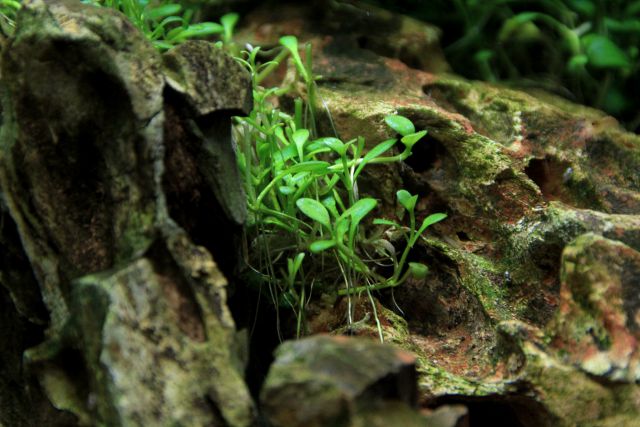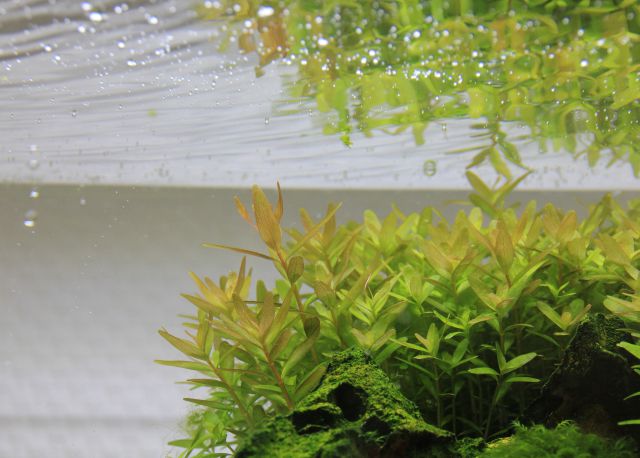In order to get answers to basic questions all around algae in the aquarium, we recommend you read this article first.
In probably every well-lit tank, sooner or later green flat extending algae coats appear that form a green patina, usually on the glass or on decoration (driftwood, rocks) and the technical equipment. These coats can look quite different, attaching very stubbornly or easy to remove simply by wiping, as they can be formed by various, sometimes multicellular green algae species. These algae coats often follow the brown, fluffy, loose diatom coats during the cycling phase of an aquarium. They are often a sign of a good water quality, which is basically positive, especially for the animals in the tank.
Aquarium keepers have different names for those 'standard' green algae coats, like 'aufwuchs algae', or 'glass algae'. The optically more obtrusive forms are green spot as well as green dust algae, which are not so easy to discern from the 'other', unspecific green algae coats. Green spot algae appear as small dots during the early stages of their development, though. Other algae coats are much more extensive. They always hold very fast on the substrate and are hard to remove. Green dust algae, in contrast, are only loosely bound to the surface, and these microscopical algae can even be removed with a few swishes of the hand or by rubbing with a finger. Green dust clouds will form in the water. If you remove dust algae this way they will simply relocate to other surfaces and populate them within hours or days, whereas "standard" green algae coats will not return that quickly when they are wiped or scraped off.
Common causes
Green algae coats are usually found in strongly lit planted tanks. A small amount of these algae in the form of a slight green patina can be deemed normal and is no reason to fret as it is absolutely harmless.

Thin green algae coat on dragon stones.
Some planted tank keepers have made the experience that a high concentration of potassium or a nitrogen supply with urea seem to enhance the growth of green algae. Use a water test to find out your potassium concentration in the water. Within this framework it is highly important to change water on a regular basis. We recommend a 50% water change per week to prevent the buildup of nutrients in the water.
In a strongly planted tank that is well fertilised you could try switching over to a nutrient supply that contains a little less potassium if you have thick green algae coats. The optimal target values for the macronutrient concentrations are:
- A CO2 content of approximately 20-30 mg/l, measurable by a permanent test with test agent
- 10 to 25 mg/l of nitrate (NO3)
- 5 to 10 mg/l of potassium (K)
- 0.1 to 1 mg/l of phosphate (PO4)
- >10 mg/l of magnesium (Mg)
In order to optimize the potassium content of the water, try to bring the level to the lower threshold of 5 mg/l. The other macronutrients, especially nitrate, should not decrease. The use of low-potassium or even no-potassium nitrate fertilisers like Aqua Rebell Makro Spezial N or Advanced GH Boost N.
If you supply lots of nitrogen in the form of urea, these algae coats may be kept in check if you switch to other nitrogen compounds like nitrate. Our nitrogen fertilisers like Aqua Rebell Advanced GH Boost N or Makro Basic Nitrat are ideal for this purpose.

Stones in the picture foreground covered in thick green algae coats.
During the cycling phase of an aquarium, green algae coats and other green algae often take over after the tank has been running for two to four weeks. Their growth spurt crowds out the diatoms, which would form fluffy brown coats in the earlier stages in the life of the aquarium. The appearance of algae during the cycling phase is absolutely normal and no reason to worry. After some time, and if the plants are aptly supplied with nutrients, the ratio of aquatic plants to algae will improve, and the latter will dwindle bit by bit. Introducing a sufficient number of algae eaters to the aquarium during the cycling phase is important - as soon as the water parameters permit. Before you start stocking the tank with animals, make sure there are no readings of ammonium or nitrite.
Control
Green algae coats can be easily controlled by algivores. The so-called sun snails (Clithon sp.) or nerites (Neritina sp.) are highly recommendable, as they rasp off these coats very efficiently.
You can remove stubborn algae coats on the glass manually during your regular maintenance routine. A blade cleaner is a highly sufficient tool for the removal of algae growing on the aquarium glass. Those layers that are only loosely connected to the substrate can be wiped off with a sponge.